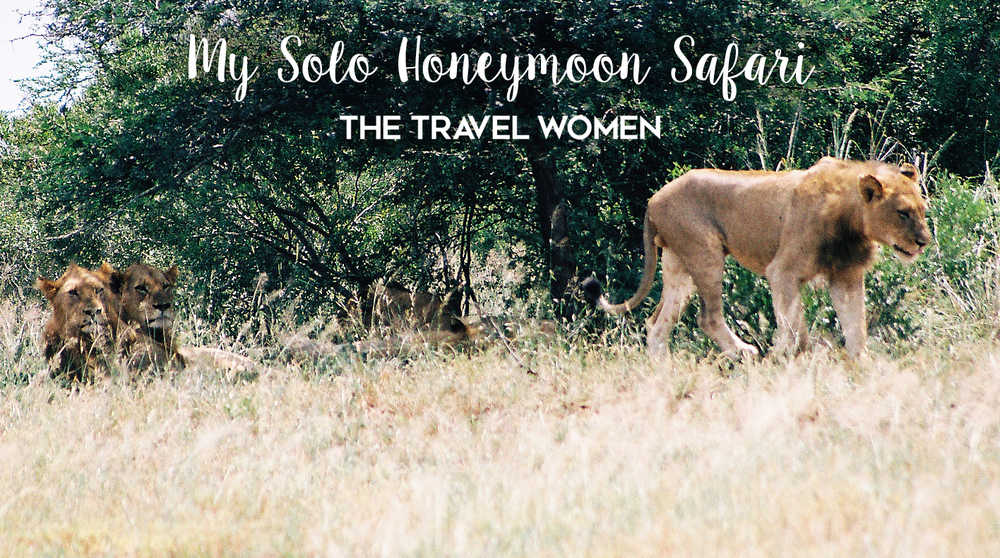
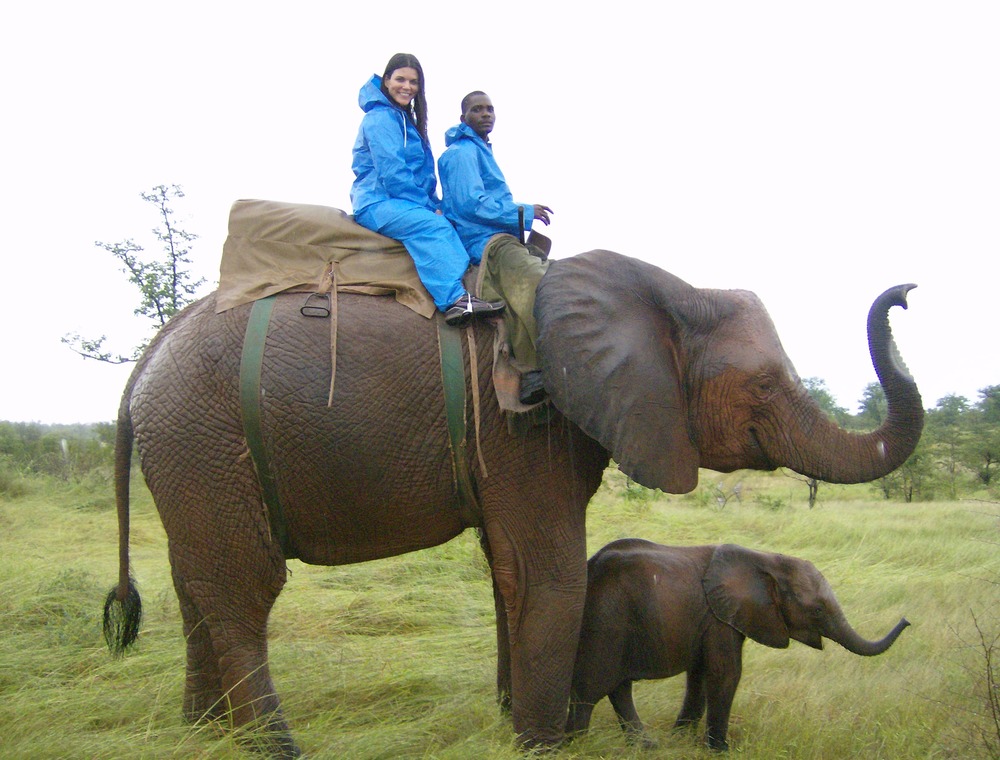

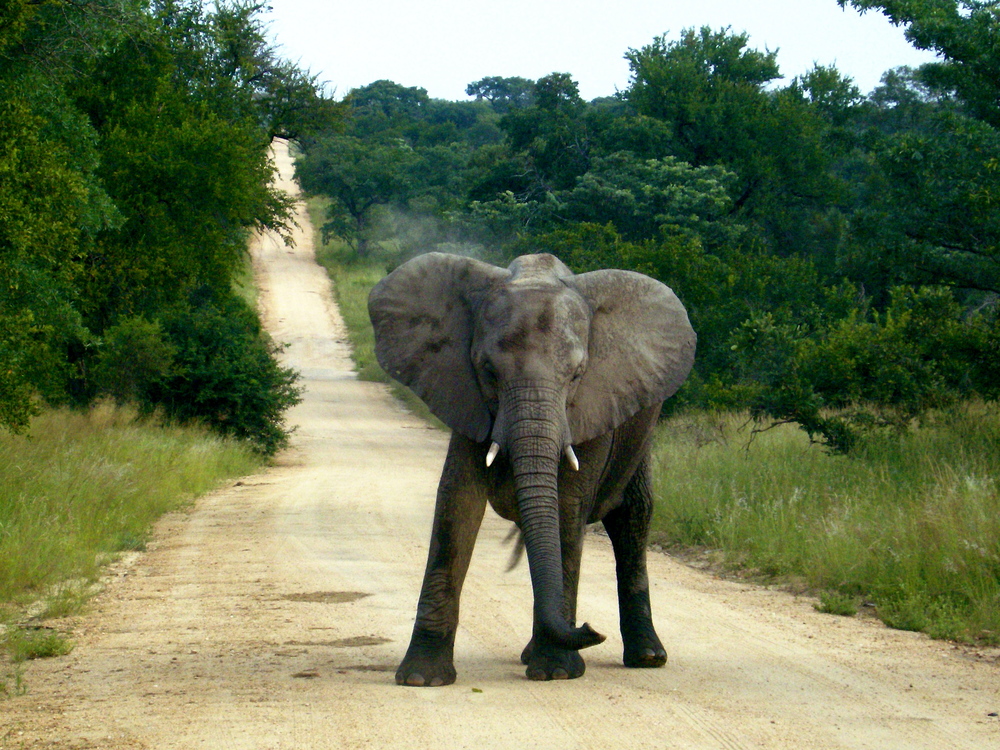
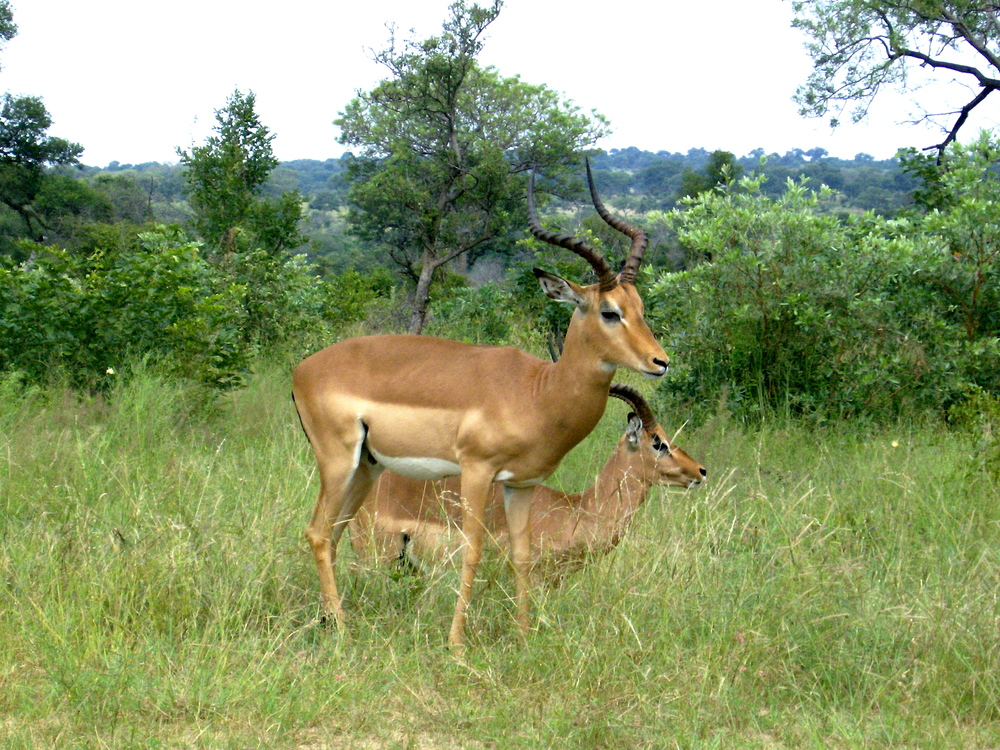
Forget Orange, Solo Honeymoons Are the New Black.
Think only couples can celebrate Valentine’s Day, Sweetest Day, and dream honeymoon trips? Think again!
Many women have fantasized about their wedding days since they were little girls. But not me! I would no sooner care if daffodils, daisies or dandelions form the centerpieces at my guests’ tables or if I wear Vera Wang or an off-the-rack dress from David’s Bridal or we say our I-do’s at City Hall. Details of the big day are not even fleeting fancies for me. In my daydreams, my mind fast forwards from the moment my betrothed has placed a dazzling, princess cut ring on my finger while we are on holiday straight to the honeymoon phase of newlywed bliss.
My honeymoon reveries always have led the future monsieur et moi on a South African safari. Before the advent of aspirational social media, I confess to being seduced by an earlier, more primal form of travel porn peddled by tourism boards: glossy tourism brochures. Years before I had ever double tapped my first photo on Instagram, stacks of thick, brochures with carefully crafted centerfolds of beautiful couples existing in sundry stages of perpetual perfection swept me off my feet. The catalogue covers would boast various iterations of couples, perched on a viewing platform overlooking the savannah. As the sun sets, they clink their champagne glasses together and watch the elephants amble below on their way to their own happy hour at the watering hole. With the turn of a page, another equally preternaturally pleasing couple would appear; she would be leaning casually on her walking stick, rapt in conversation with the guide while her gent captures a photograph of a giraffe nuzzling its young. Flipping through the page revealed one setting more perfect than the next. I knew these phantasmal couples were a sham, their only purpose to entice travelers to open their wallets in hopes of recreating the picture perfect vacation and I wanted in!
When a friend had pulled up stakes and moved to Cape Town, I raced to the computer and booked my flight. Cape Town is often the preferred gateway to a safari even though it is further afield than Johannesburg to South Africa’s prime game viewing territory. With my trip booked, the chance for a safari adventure had never been closer at hand. Unfortunately, my friend was afflicted with safari fatigue and was not able to join me. With no mister in sight, I vowed to stop bogarting a safari for my honeymoon. I threw myself a solo honeymoon!
As a solo female traveler in Africa looking to embark upon what is customarily viewed as a luxury vacation, safety, budget, and whether to stay at a private game reserve or public park were forefront considerations. At private game reserves guests experience lavish stays with amenities such as sky beds for stargazing into the Milky Way, open-air spa treatments, Michelin-worthy haute cuisine, and a near guarantee to see the Big Five at close range with off-road expeditions. The “Big Five” is a term bestowed upon black rhinos, buffalos, lions, elephants, and leopards as these mighty warriors were once considered the five most dangerous animals to hunt. Traveling in the lap of luxury would necessitate a shorter stay as I would need to fork over a tidy sum, especially after factoring the single supplement into the already pricy daily rate. A public game reserve would be more economical and allow me more days to be on my wildlife scavenger hunt and for better or worse, it would mean a more independent, less coddled and predictable trip.
I researched private game lodges in the Limpopo and Mpumalanga provinces, the heart of the Big Five Territory. Like a lioness snaring her prey, I stalked online forums, gleaning advice from others. Many commentators suggested that private game reserves have the potential to diminish the thrill of game spotting as rangers piggyback on the discoveries of other rangers. Once the extravagant frills are stripped away, choosing between a public and private game reserves depends on the type of traveler one is. It is a question of whether one is a lion or a lioness. Lionesses are primarily responsible for hunting for their pride while lions place a takeout order with the ladies and wait for their seamless delivery service to arrive on their doorstep. Having my own private plunge pool, outdoor shower, and personal butler was an alluring prospect that was hard to forsake, but I am a lioness traveler whose joy in traveling, in part, is derived from active exploration.
Self-drive safaris are easy enough to arrange, however, I wanted my eyes focused on wildlife spotting, not on the road. This was one of the rare occasions I called upon a regional expert to assist me in locating a tour I could join. I chose Go2Africa because it was the only company that respected that my travel slush fund was not limitless when other tour operators made me feel ashamed of my “meagre” budget, only further reinforcing how out of my depth I felt. My travel agent found me the perfect tour within Kruger National Park, staying at various campsites within the park.
My safari troop was comprised of a British couple, also on their honeymoon, and our guide Neil. Neil picked us up at the Outlook Lodge, a charming bed and breakfast located in a residential section of Johannesburg. Neil provided us with a narration of South African history during the drive, which takes between 4-6 hours depending upon which gate is used to enter the park.
We entered the park via the Paul Kruger Gate, located deep within Rhino territory. It was the rainy season and the bush was thick with vegetation, providing the wildlife with protective camouflage. Game viewing during the wet season is more challenging because animals are not forced to visit watering holes due to the abundance of water. I was skeptical that we would see much game, but I need not have worried. We spotted impala, elephants, zebras, white rhinos, wildebeests, warthogs, baboons, kudus, springbok, and steenbok within our first afternoon.
We camped at Skukuza, the largest of all of Kruger’s self-catering campsites. We stayed in air-conditioned rondavels, traditional round African homes with thatched roofs complete with en-suite bathrooms and separate kitchens. The accommodations were clean, comfortable and basic. Each rondavel had a barbecue, or braai in Afrikaans, which Neil, our pit master, used to prepare our dinner. Neil introduced us to South African delicacies including ostrich steak, warthog sausage, various types of Biltong, a cured meat similar to jerky and an array of “pâtes”. We sampled Kudu, Springbok, and Eland Biltong and ostrich and zebra “pâté.” The oenophile in me was satiated as Neil served South African wine with dinner. Every night I felt like an overfed, boozy lion.
Except for when we relocated to the Letaba camp, located further north in elephant country, our daily routine was the same. We would wake at 4:30 a.m. to scarf down a petit dejeuner consisting of coffee or rooibos tea (red bush tea) and Rusks. Popular since South Africa’s frontier days, Rusks, hard dried biscuits, are South Africa’s answer to the Biscotti.
After our traditional Afrikaner’s breakfast, we would pack our picnic supplies for lunch and head out for a full day’s game drive as soon as the gates to the campsite opened at 6 a.m. For safety reasons all park visitors must arrive at their campsite by 6 p.m. before the gates are locked for the next twelve hours. Nightfall envelops the savannah quickly and without special lighting, it is impossible to spot the elephantine wildlife on the prowl. Once car engines cease to purr for the evening, the animals, no longer scared off by the sounds of modernity, become the master of the kingdom. Big cats will often sleep on the paved roads, which begin to cool off after sundown and serve as a make-shift, au natural air-conditioning. The first car to leave the camp in the morning has the best chance of an up-close encounter with wildlife. Luckily, I was matched with likeminded, Type-A travelers who wanted to be the first to spot wildlife before anyone else had a chance to disturb their slumber. Our eagerness paid off, and we spied a lion sleeping at the side of the road and hippos on their way to the river for their morning baths.
Wildlife is most active in the morning and late afternoon, but even at optimal viewing times, the wildlife can be difficult to view. Excitement would give way to bush burnout and our eyes would glaze over as we stared into the wilderness for signs of life. Hours sometimes seemed to pass without a glimpse of anything except impalas and springboks, animals as common to the African bush as squirrels and pigeons are to Central Park. Then suddenly, the bush would spring to life, rewarding us with a sighting so fantastic that it felt as if we were participants in a National Geographic documentary. One such instance occurred when we spotted five lions snuggling under a Baobab tree seeking shade from the punishing African sun. Another occurred when a hyena skulked over to examine our vehicle. In typical hyena fashion, he was hunched over, his poor posture on display like an overworked office worker, as he sized us up to see how good we might taste.
On our last day, shortly before exiting the park, we saw a family of elephants sauntering through the bush. They moved swiftly and with more elegance than I expected from animals of their stature. I have always found a curious grace to these gentle giants. With a complex emotional make-up and social structure, elephants exhibit human like behaviors in their relationships. They form deep attachments and grieve the loss of a loved one. They bury their dead by covering their fallen comrades with leaves and branches. As if to acknowledge the propriety of mourning their brethren, they will sit shiva and visit grave sites.
One elephant took particular interest in us. He broke off from the group and stood alert in the middle of the road with his ears flared out. He walked slowly towards us swaying his trunk from side to side like a scarf blowing in the wind before calmly walking by our car, coming within inches of my window. It was a surreal moment in which he seemed to want to wish us farewell, but then thought better of it. He left to rejoin his parade and quickly disappeared into the trees and we reluctantly said our goodbyes to Kruger.
My solo honeymoon forever altered my perception not only about the sanctity of wildlife and need for conservation, but also about traveling. Looking back it seems asinine to me now that I felt I needed a traveling companion to venture on a trip of a lifetime. It is said that a man travels the world over in search of what he needs and returns home to find it. I went to Africa looking for adventure and I returned home liberated from social mores and my own fears of traveling alone.
Pin it:
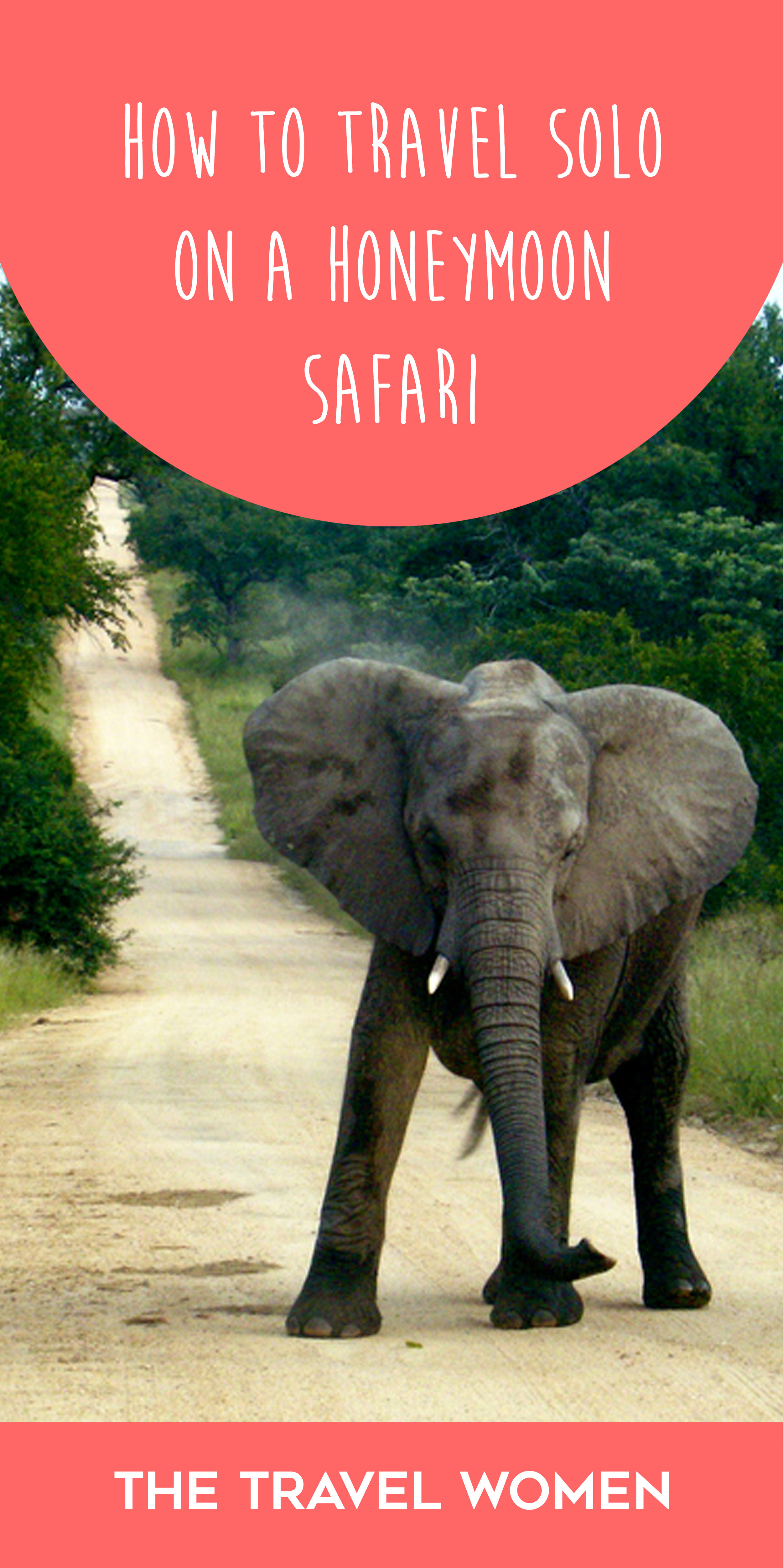

This is so relevant as I had been looking into doing a safari and thinking I couldn’t do it without a husband! Haha! Thanks for such a brilliant read, it sounds like you had a great trip!